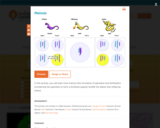
This article explains how and why mutations are so important to genetics.
- Subject:
- Mathematics
- Science
- Material Type:
- Reading
- Provider:
- Cold Spring Harbor Laboratory
- Date Added:
- 08/28/2023

This article explains how and why mutations are so important to genetics.

This article contains information on how DNA is repaired to prevent mutated damage from interrupting DNA processes.

This is a thorough site which contains a glossary of plant/animal cell anatomy terms. Diagrams of both cells are included along with worksheets to label.

This pathway provides an introduction to genetic disorders including examining the different ways genetic information may be changed and specific examples of genetic disease. For a deeper look at this topic, we recommend the pathway Modern Understandings of Inheritance from the OpenStax textbook Biology for AP® Courses.

This site from the University of Arizona runs a two-step simulation of Genetic Drift. There are teacher's notes included. A great site to aid in understanding Genetic Drift.

Explains the goals of the Human Genome Project. It also explains some of the ethical, legal and social challenges associated with this new technology.

Meiosis is the process by which gametes (eggs and sperm) are made. Gametes have only one set of chromosomes. Therefore, meiosis involves a reduction in the amount of genetic material. Each gamete has only half the chromosomes of the original germ cell. Explore meiosis with a computer model of dragons. Run meiosis, inspect the chromosomes, then choose gametes to fertilize. Predict the results of the dragon offspring and try to make a dragon without legs. Learn why all siblings do not look alike.

Students perform an activity similar to the childhood “telephone” game in which each communication step represents a biological process related to the passage of DNA from one cell to another. This game tangibly illustrates how DNA mutations can happen over several cell generations and the effects the mutations can have on the proteins that cells need to produce. Next, students use the results from the “telephone” game (normal, substitution, deletion or insertion) to test how the mutation affects the survivability of an organism in the wild. Through simple enactments, students act as “predators” and “eat” (remove) the organism from the environment, demonstrating natural selection based on mutation.

Students learn about mutations to both DNA and chromosomes, and uncontrolled changes to the genetic code. They are introduced to small-scale mutations (substitutions, deletions and insertions) and large-scale mutations (deletion duplications, inversions, insertions, translocations and nondisjunctions). The effects of different mutations are studied as well as environmental factors that may increase the likelihood of mutations. A PowerPoint® presentation and pre/post-assessments are provided.

This link has many tools to help understand the revolutionary sciences and discoveries in genetics.

Psychology is designed to meet scope and sequence requirements for the single-semester introduction to psychology course. The book offers a comprehensive treatment of core concepts, grounded in both classic studies and current and emerging research. The text also includes coverage of the DSM-5 in examinations of psychological disorders. Psychology incorporates discussions that reflect the diversity within the discipline, as well as the diversity of cultures and communities across the globe.Senior Contributing AuthorsRose M. Spielman, Formerly of Quinnipiac UniversityContributing AuthorsKathryn Dumper, Bainbridge State CollegeWilliam Jenkins, Mercer UniversityArlene Lacombe, Saint Joseph's UniversityMarilyn Lovett, Livingstone CollegeMarion Perlmutter, University of Michigan


By the end of this section, you will be able to:
Explain the basic principles of the theory of evolution by natural selection
Describe the differences between genotype and phenotype
Discuss how gene-environment interactions are critical for expression of physical and psychological characteristics


This video explains how DNA works and what it does, relating it to an instruction manual for building an organism. [4:29] Followed by a short quiz and a list of additional resources to explore.

This detailed article from the Nobel e-Museum explores Thomas Hunt Morgan's career and research in genetics. Read how Morgan's work influenced later scientists and the modern scientific world.

This site opens with an excellent introduction to Cytogenetics. Explore this site to learn about chromosomes, human karyotypes and more.

Students use DNA profiling to determine who robbed a bank. After they learn how the FBI's Combined DNA Index System (CODIS) is used to match crime scene DNA with tissue sample DNA, students use CODIS principles and sample DNA fragments to determine which of three suspects matches evidence obtain at a crime location. They communicate their results as if they were biomedical engineers reporting to a police crime scene investigation.